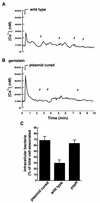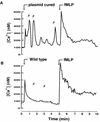Yersinia pseudotuberculosis-induced calcium signaling in neutrophils is blocked by the virulence effector YopH
- PMID: 10225922
- PMCID: PMC116005
- DOI: 10.1128/IAI.67.5.2567-2574.1999
Yersinia pseudotuberculosis-induced calcium signaling in neutrophils is blocked by the virulence effector YopH
Abstract
Pathogenic species of the genus Yersinia evade the bactericidal functions of phagocytes. This evasion is mediated through their virulence effectors, Yops, which act within target cells. In this study we investigated the effect of Yersinia pseudotuberculosis on Ca2+ signaling in polymorphonuclear neutrophils. The intracellular free calcium concentration in single adherent human neutrophils was monitored during bacterial infection and, in parallel, the encounter between the bacteria and cells was observed. When a plasmid-cured strain was used for infection, adherence of a single bacterium to the cellular surface induced a beta1 integrin-dependent transient increase in the intracellular concentration of free calcium. This was, however, not seen with Yop-expressing wild-type bacteria, which adhered to the cell surface without generating any Ca2+ signal. Importantly, the overall Ca2+ homeostasis was not affected by the wild-type strain; the Ca2+ signal mediated by the G-protein-coupled formyl-methionyl-leucyl-phenylalanine receptor was still functioning. Hence, the blocking effect was restricted to certain receptors and their signaling pathways. The use of different Yop mutant strains revealed that the protein tyrosine phosphatase YopH was responsible for the inhibition. This virulence determinant has previously been implicated in very rapid Yersinia-mediated effects on target cells as the key effector in the blockage of phagocytic uptake. The present finding, that Y. pseudotuberculosis, via YopH, specifically inhibits a self-induced immediate-early Ca2+ signal in neutrophils, offers more-detailed information concerning the effectiveness of this virulence effector and implies an effect on Ca2+-dependent, downstream signals.
Figures





References
-
- Andersson K, Carballeira N, Magnusson K-E, Persson C, Stendahl O, Wolf-Watz H, Fällman M. YopH of Yersinia pseudotuberculosis interrupts early phosphotyrosine signalling associated with phagocytosis. Mol Microbiol. 1996;20:1057–1069. - PubMed
-
- Aplin A, Howe A, Alahari S, Juliano R. Signal transduction and signal modulation by cell adhesion receptors: the role of integrins, cadherins, immunoglobulin-cell adhesion molecules, and selectins. Pharmacol Rev. 1998;50:197–263. - PubMed
-
- Bei L, Hu T, Qian Z, Shen X. Extracellular Ca2+ regulates the respiratory burst of human neutrophils. Biochim Biophys Acta. 1998;1404:475–483. - PubMed
Publication types
MeSH terms
Substances
LinkOut - more resources
Full Text Sources
Miscellaneous

